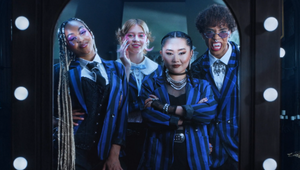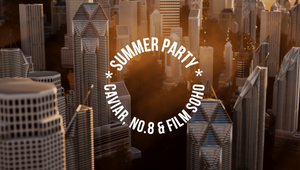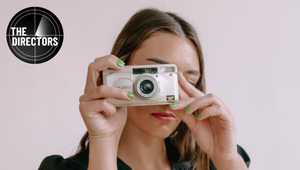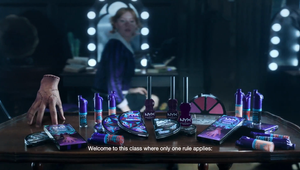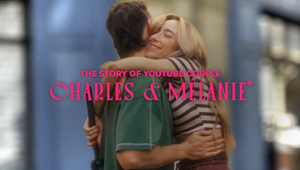
5 Minutes with… Henry Scholfield

Kinetic, colourful and clever – welcome to the world of director Henry Scholfield. Last year, he joined the billion-view club on YouTube with his Dua Lipa promo New Rules and his latest effort for the dream-pop singer-songwriter, IDGAF, is a sharply styled and choreographed dance-off. It’s also another repeat collaboration, not just with Dua but with creative tour-de-force Stromae, who lent his brains to IDGAF and for whom Henry has also directed some smashing videos.
Henry’s commercials and music videos are that rare combination of substance and style; he’s come a long way since nicking his sister’s camcorder in his early 20s. Music video fans will know him from his collabs with Professor Green or perhaps his mind-bending Will Young promo Losing Myself – while on the ad side, he’s got an eye-catching reel, including the Argos Christmas yetis and some bonkers stuff for Tele2. These days you’ll find him repped all over the place by Caviar. LBB’s Laura Swinton caught up with him as he was out and about in Spain.
LBB> Do you remember the first time you picked up a video camera?
HS> I do! My sister wanted to be an actress and so she got a video camera. I had no idea about it. It was quite late though, I was 22 or 23. Basically she asked if I could film her for some auditions, so I did. And… then I basically nicked her camera and started shooting anything and it drove her crazy because I always had it. It was just one of those shitty Handycams. I was hyperactive, going out on night shots, shooting cats in the street… I was crazy with it.
It’s our generation’s version of the Super 8, it carries such a nostalgia to it.
LBB> So you were sort of late to filmmaking, but were you a creative kid in other ways?
HS> My mum was a painter and I loved art, but I was terrible at drawing, so I had to drop that. I was convinced I was going to be an inventor. It’s really weird! I used to make crazy things in Design & Technology.
I convinced my father to give me our old lawn mower engine and I spent the summer trying to turn my skateboard into a motorised skateboard. Massive fail.
LBB> Did you get it moving at least?
HS> Weirdly enough, I got the wheels moving… just not with anyone on it. I couldn’t get enough power into the wheels. I had no idea what I was doing, I had all these complicated engineering books that I didn’t understand.
LBB> It’s funny because a lot of your videos have that in-camera inventiveness and you can see the roots of that engineering mindset, problem-solving brain.
HS> I think that’s something I’ve always been into: what’s possible and what’s not possible. It’s like a magician. I read this book once called Hiding the Elephant. Essentially the theory of magic was that you first think of the illusion that you want to create and then you work out how to do it. I thought that was a really interesting way of looking at anything. It’s more original than going the other way – like this trick works how do you do something with it.
LBB> When was your first attempt at a music video after you’d annoyed your sister?
HS> I made this hilariously bad breakdancing short film – I used to be a breakdancer. I was at university and, once again, didn’t know what I was doing. I tried to find a job in the industry. Eventually I bumped into someone who knew someone who knew this guy Example, who was a London rapper on Mike Skinner’s label. And he was really cool and we had this idea to get an old costume from the old ‘70s Monkey TV show and just run around London with him in it. We spent a hundred quid and made a music video and it was a hit. Skinner liked it and it was really funny. Then we did the next one and the next one.
LBB> So when it comes to what project you want to work on, I heard you say at a talk that the ‘track chooses you’. What that feels like, what are you listening out for when you think ‘yeah, I have an idea for that’.
HS> I think it’s somewhere between an emotional response and a neuron response. It’s like when you walk into a gallery and with half the stuff, you don’t get it at all. And then you find yourself standing in front of the same painting for half an hour thinking ‘wow, this is something’. It makes your brain start working.
It’s that kind of feeling, that’s what I mean about it choosing you. You fall in love with it because you know that through it you can express something else you’ve got in your head. The visual builds itself through your head while you’re listening. And you get super excited and then you get desperate that you want to do it. Obviously if you don’t get it there’s the pain of rejection.
The thing that’s difficult is when you get a project that you’re very keen to do for other reasons but you have to think your way round it… that said, it’s not impossible. Sometimes you find the through line. Sometimes I’ll get a project and I’ll start watching the artist doing live performances to see what it is in them and maybe you’ll see a small moment and you’ll think ‘that’s the soul of this person, now I understand the track and now I have something that I think will really work for it’.
LBB> It’s probably a very different kettle of fish, but what about when you’re deciding if you want to work on a commercial project? Do you ever get that emotional response or is that limited to music video side of things?
HS> Oh definitely! You do. I’m lucky enough these days that I get the chance to work on good advertising scripts. Sometimes a creative idea arrives and you feel like you could have been in the same room as the creatives. You think ‘oh this is great’ and immediately you’ve got stuff that you feel like you can add to it, ways you can interpret it that will make it better, cooler, funnier, more emotional.
LBB> I wanted to touch on one of my favourite videos of yours is - the Stromae promo Tout Les Memes. The craft of it is so clever, as is the choreography, but it all really comes alive thanks to his performance – how did you work with him to get that performance?
HS> I think, in a way, working with Stromae taught me something. We really talked about the theory of the characters and I think with performance what you’re always looking for is depth. Performance isn’t ‘you raise your eyebrows here, you move your lips, you do this, you do that’. Performance is at its best when it’s telegraphing emotion.
When I was working with Paul [Stromae] we would look back at the performances within the choreography as well, and once we had the layer of the movement down we’d talk about what it was within the song and the personalities he was portraying that he wanted to get out there. Therefore, in doing a performance it became something ‘extra’. It was no longer about singing a song or portraying a character at a base level, it goes much deeper.
And he’s a genius. Paul is brilliant. His body control and performance control are amazing. He’s super talented.
LBB> And you recently worked with him on the new Dua Lipa IDGAF video, right?
HS> I’d done New Rules and the management had asked if I wanted to do the next one. I think they wanted to work with Mosaert, Stromae’s creative company on other stuff in the future and to have a presence in France. And they said would you like to do something with Mosaert – Stromae and Luke. Absolutely! I was in Belgium anyway, weirdly, on a commercial job. I hung out with them for three days and came up with so many different ideas. It was super fun. I guess that’s what happens when you put three almost-crazy people together in a room! We laid down the base of the concept there and I went away to work with Marion Motin to develop the choreography.
LBB> Going back a step – the previous Dua Lipa video New Rules got a squillion hits!
HS> My mother sent a text when it hit a billion! She said, ‘I can’t believe it, I’m popping champagne!’ It was so funny.
LBB> So with Dua Lipa, she’s another repeat collaboration. Is chemistry important for creative collaboration?
HS> I think so. It can be another way if you have a clear through line for an artist. I think for this particular one, it needed to have Dua in it. And what was great is we had done a video before and we clicked and we wanted to do something that felt very true to her as well.
I think sometimes when there’s a message in the music, the artist needs to be involved. Not necessarily in the sense that they want this or that visual - it doesn’t have to be like that - but whether they want a certain message to come across, or if something feels right or wrong to them. Just like in Tout Les Memes, that kind of collaboration produces something that feels truer to the music and the artist. So, when the artist comes to perform, they nail it because it’s true to them. If we can get some authenticity in there then the visual is always more compelling, even if the viewers don’t know why.
LBB> Out of all the projects on you’ve worked on, which ones are the ones that you have that real soft spot for – whether they’re your favourite because you think they’re the best or you just have the best memory of making?
HS> Will Young’s a good one. I was working with this choreographer called Aletta Collins and we just spent a week making everything perfect. And again, there’s a lot of theory within the choreography. For the mirror sequence we talked about the ghostly versions of his alter egos and psychological trauma and stuff like that. It was a really great process.
Stromae obviously was great after we spent several weeks making that come together.
I had a really great time in November doing a film for the Red Cross, which was amazing. We street cast the little boy in it and it was a really powerful message about not bombing civilians, schools and hospitals and population centres. We were blowing up the schools and it was very traumatising but it’s the first time in a long time that I’ve felt useful. A little bit useful. The little kid was amazing.
And I loved working with Marion Motin again on the new Dua. The choreographer is amazing, the way her mind works is great.
LBB> When it comes to choreography, it’s quite prominent in your videos. Are you quite into dance yourself, whether watching it or taking part?
HS> Before she was a painter, my mother was a dancer. She was in the Edinburgh Ballet. She used to take me to lots of dance stuff while my mates were going to the football… but I loved it. I’ve always watched a lot of dance and, like I said, I used to be B-boy at the hip hop championships.
I think it’s an incredible way to tell stories. In a lot of my work, people always ask me ‘who’s your choreographer?’. There are amazing choreographers out there and I work with different ones depending on the project, but I think if you’re into dance you have to study it. You can’t be into aesthetics without knowing the masters of painting. I’ve spent a lot of time studying it and it’s something I’m very into, that’s why it comes out in the work. And when I’m doing a dance piece, I’m there with the choreographer for a day before coming up with ideas and then in rehearsal I’m there with my iPhone camera figuring out different shots and responses to the dance moves.
LBB> This might sound flowery, the camera feels like a dancer itself, whether it’s the way it moves, your fluid transitions, how it interacts with the dancers.
HS> Absolutely. In fact, my personal pet hate - and this comes from knowing a lot of dancers – is when you see a video and you know the talent of the dancers and all you see is wide shot cut together with random mid shots and none of the movement makes sense. And you know it would look amazing if they’d put the camera in the right place.
Like I say, the movement of the camera within the dance tells you a lot. If you don’t know where to put your camera, just put it in a wide shot. But obviously for me, I spend a lot of time working out where the camera can be to capture a certain movement or emotion. A lot of the time I will be the one who is watching rehearsals like a camera.
LBB> It’s funny, I saw a talk with Tony Kaye and he sees the camera as an actor and gets right up in their faces.
HS> It’s one of these things. The personality of the camera is always important in all types of filmmaking. Is it a distant omnipresent thing or is it like Tony Kaye’s films where it’s an actor in the scene? I don’t know, is it the point of view of someone else? You’ve got to ask yourself that question before you start anything.
LBB> And another prominent feature in a lot – though not all – of your work is that fluid and creative way of moving from scene to scene that are often in-camera tricks. Don’t take this the wrong way, but it speaks to me of a mind that doesn’t want to sit still!
HS> That’s true! My god, I feel like I’m in the psychologist’s chair now. I think it’s because a lot of my favourite filmmakers take you on a journey. In a way, in my own head, I look for that way to take you from one place to another without disruption. It doesn’t always mean transition technique, it’s more about the flow.
One of the first films I saw that made me think, ‘my God I’d love to be a filmmaker’, was La Haine. It’s a French film. It’s a black and white and it uses sound transitions and editorial transitions. You’re following these three guys from the suburbs to the heart of Paris and you never feel like the film stops. But there’s no techniques as such but the way that the film flows together you feel like you’re never jumping in time, you never miss a moment.
So, there’s that, and, like you said, my mind never sits still.
LBB> In terms of the stuff that inspires you – are there any directors that you really admire? What inspires you and what do you get up to in your down time? Maybe it’s nothing to do with watching films!
HS> I remember when I first discovered filmmaking I got the Cannes directors’ reels. I think every director of my generation had them. It was Michel Gondry, Spike Jonze and Jonathan Glazer; I’d watch it on repeat thinking ‘that’s amazing’. Those three obviously were three very different visual artists.
I’m a big fan of different directors and I think there are a lot of very talented directors out there now. Look at the Daniels. Ninian [Doff], I love his stuff. Or Hiro Murai. Hiro I knew from my Partizan days and his work in the past three years has become amazing. It’s great to look at the old ones but it’s great to know what’s out there now.
…Having said that I hardly watch any music videos now! I go to a lot of exhibitions, with a lot of artists that I love, I look at a lot of photography and read a lot of books. I’m a real believer that to get to good original ideas you’ve got to look in other places. As much as I love the work, I usually only watch stuff that’s passed onto me by friends because you can’t let that be the main thing that gives you inspiration. You get inspiration by watching a couple having an argument in a café. You’ve got to look in the places other people aren’t looking at that moment.









